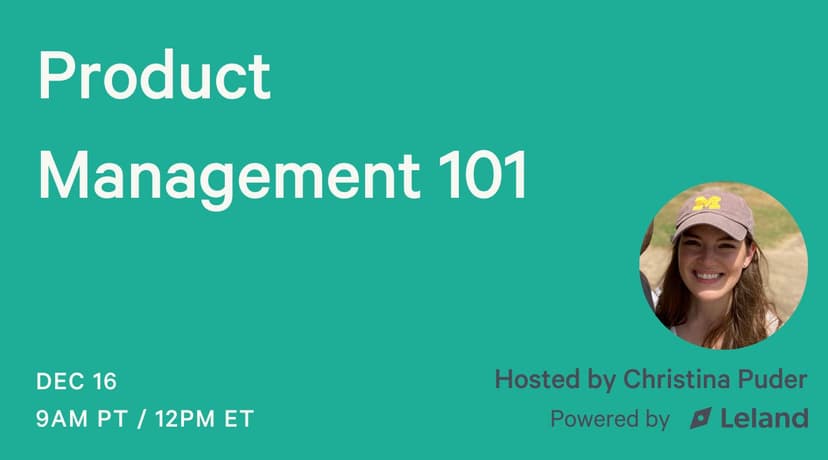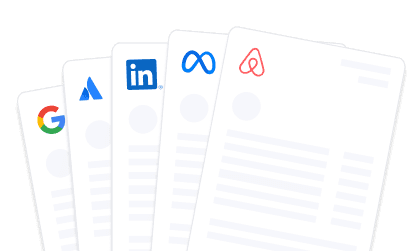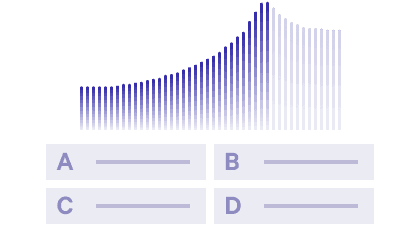Apple Product Manager Interview: Process, Questions, & Tips (2025)
Preparing for the Apple product manager interview? Learn exactly what to expect, how to stand out, and what Apple is really looking for.
Posted September 12, 2025

Join a free event
Learn from top coaches and industry experts in live, interactive sessions you can join for free.
Table of Contents
Apple’s product manager interviews are known for being rigorous, unique, and deeply aligned with Apple’s values. If you're preparing for one, you already know you're aiming for one of the most coveted roles in tech, and that means standing out across every stage of the Apple PM interview process.
This guide will walk you through everything: what to expect in each round, how to prepare for PM-focused interviews, what types of interview questions to expect, and how to demonstrate the product sense, technical fluency, and user obsession Apple looks for.
Read: The Different Types of Product Management: An Overview of Specialist PM Jobs
What Makes Apple’s PM Interviews Unique?
Unlike other tech companies, Apple is fanatically focused on quality and user experience, not just growth. That difference shows up in the entire interview — from the recruiter phone screen to the final interview loop.
Here’s what sets Apple apart:
- Apple’s culture prizes craftsmanship, cross-functional collaboration, and long-term product thinking.
- Product vision is evaluated not just on strategy but on how well you reflect Apple's core values.
- Interviewers probe your ability to incorporate user feedback, manage technical constraints, and align with business objectives.
- You’ll often be tested on how you consider visually impaired users, user privacy, and diverse user needs.
Apple Product Manager Interview Process (Stage-by-Stage Breakdown)
Apple’s product manager interviews are famously rigorous and intentionally so. They’re designed not just to evaluate your experience, but to uncover how you think, what you value, and whether you can uphold Apple’s uncompromising standard for simplicity, elegance, and user trust.
Here’s what the interview process typically looks like, with tactical insights to help you succeed at every stage.
Recruiter Phone Screen
The first step is a conversation with a recruiter, who’s primarily evaluating whether you’re a general fit for the Apple product manager role. You’ll cover familiar ground, such as your resume, background, and interest in the position, but don’t mistake this for a casual screen.
Expect questions like:
- “Why Apple?”
- “What makes you a good fit for this team?”
- “Walk me through your product management experience.”
This is where your alignment with Apple’s culture first gets tested. It’s not enough to say you admire their products; you’ll want to demonstrate a thoughtful understanding of Apple’s mission, design philosophy, and values. Talk about what simplicity means in practice. Reference user privacy or ecosystem integration. Show that you don’t just want to work at Apple, but you think like Apple.
Hiring Manager Interview
If the recruiter gives you the green light, you’ll move on to speak with a hiring manager, often a senior PM or director. This conversation goes deeper. You’ll be asked about your product development approach, your experience working across cross-functional teams, and how you define and measure success.
Expect the discussion to include real, challenging examples. You might be asked how you’ve handled conflict with engineering teams, how you’ve prioritized under technical constraints, or how you’ve used user feedback to shift direction. One candidate on Blind shared that their interviewer “drilled into every product decision, not just what I did, but why I did it.” That level of depth is typical.
You should also expect at least one or two behavioral questions, such as “Tell me about a time you had to push back on design” or “How did you resolve a disagreement between design and engineering?” Apple wants PMs who can lead without authority, make principled tradeoffs, and align decisions with business objectives while fiercely protecting the user experience.
Read: The 10 Most Common Product Management (PM) Behavioral Interview Questions
Virtual or On-Site PM Interviews
This is the heart of the process: a multi-round loop usually consisting of three to five interviews. Each round focuses on a different core skill: product sense, execution, technical fluency, or behavior. While the order may vary, the expectations are consistently high.
In the Product Sense interview, you'll be asked to solve open-ended problems, often involving core products like the Apple Watch, Apple TV, or Apple Music. You might be asked to design a new feature, identify opportunities for a user segment like visually impaired users, or explain how you’d improve retention. Your interviewers are looking for structured thinking, clear assumptions, and a deep concern for user needs.
To do well, you’ll need more than just frameworks. Apple expects you to reason from first principles. That means identifying specific user segments, considering real-world constraints like ecosystem limitations or privacy regulations, and grounding your decisions in Apple’s aesthetic and strategic values. Simply mimicking generic PM responses won’t cut it.
The Technical Interview focuses on how well you work with engineering. While you won’t be asked to code, you’re expected to demonstrate strong technical knowledge, not just about systems and APIs, but about how product decisions impact technical complexity. You may be given a prompt like, “What would you do if user satisfaction scores dropped after launching a new feature?” Your answer should explore root cause analysis, working alongside engineers, and weighing tradeoffs between short-term fixes and long-term solutions.
In the Execution & Metrics interview, the focus shifts to performance and accountability. You’ll be asked how you define success, what key performance indicators you use, and how you respond when things don’t go as planned. Common prompts include: “How would you measure the success of a new Apple Pay onboarding flow?” or “What key metrics would you use during a beta rollout?” Interviewers want to see that you can distinguish between leading and lagging indicators, handle ambiguity in early-stage products, and communicate results clearly to stakeholders.
The final portion is often a dedicated Behavioral Interview, although behavioral questions may appear throughout. These questions go beyond the usual “tell me about a time” format. Apple interviewers often probe for alignment with Apple's culture, particularly in moments when you had to make hard calls. They want to see if you’ve ever advocated for accessibility, challenged assumptions to improve user privacy, or stood your ground in support of quality and user experience, even when it would have been easier not to.
Read: The Ultimate Product Manager Interview Guide
Optional: Final Round or Lunch Interview
In some cases, candidates report a less formal final conversation, sometimes over lunch, sometimes virtual. Don’t let the casual setting fool you. These are often soft evaluations of how well you’ll fit within the team’s dynamic, how you communicate ideas, and how you think off-script.
You may be asked about your views on product strategy, how you’d approach leading a new Apple product, or how you see your role evolving in the context of emerging technologies. Treat this round as a final opportunity to reflect Apple’s values and show that you’re not just capable but you’re unmistakably Apple.
Common Apple PM Interview Questions (And How to Answer Them)
| Type | Sample Question | What They’re Really Testing | What a Strong Answer Shows |
|---|---|---|---|
| Product Sense | “How would you improve Apple Music for Gen Z users?” | Ability to generate user-first solutions, craft a compelling product vision, and connect ideas to real user behaviors and business value | Deep understanding of user segments and user needs, a thoughtful feature idea tied to Apple's values, and smart metrics to measure success |
| Metrics & Execution | “What’s your North Star metric for a new feature in Apple Pay?” | Clarity under ambiguity, prioritization of the right success signals, and a connection between user impact and business objectives | Well-defined key performance indicators, tradeoffs between metrics (e.g., retention vs. engagement), and a rationale for why your metric drives product health |
| Behavioral | “Tell me about a time you had to push back on a designer’s decision.” | Self-awareness, principled decision-making, and the ability to navigate cross-functional tension in a high-bar, opinionated environment | Empathy for stakeholders, ability to articulate tradeoffs, and alignment with Apple’s culture around simplicity, quality, and long-term thinking |
| Technical Collaboration | “How do you ensure engineers are aligned with the product vision?” | Comfort working with deeply technical teams, communication skills, and an appreciation of constraints and feasibility | A repeatable process for alignment (PRDs, whiteboarding, prototyping), respect for technical constraints, and a true partnership with engineering teams |
| Accessibility & Privacy | “How would you design a product that protects user privacy by default?” | Understanding of Apple’s stance on privacy, ability to make hard tradeoffs, and awareness of regulations and user trust implications | Design that minimizes data collection, aligns with user preferences, and still delivers value — without compromising the experience |
| Execution in Crisis | “A key feature failed after launch. What do you do?” | Crisis management, root-cause thinking, and the ability to protect both user satisfaction and team morale under pressure | Calm response plan, smart use of qualitative feedback and telemetry, and the ability to balance short-term fixes with long-term solutions |
| Product Strategy | “What’s your long-term vision for the Apple Watch?” | Big-picture thinking, strategic planning, and the ability to balance innovation with Apple’s brand, ecosystem, and business objectives | Clear POV, roadmap phasing, potential for innovative features, and deep consideration for Apple’s role in emerging categories like health or accessibility |
| Cross-functional Leadership | “Tell me about a time you rallied a cross-functional team around a difficult goal.” | Leadership, influence without authority, and the ability to drive alignment across design, engineering, legal, and business teams | Clear articulation of the challenge, intentional use of influence strategies (1:1s, narrative docs, shared metrics), and reflection on how alignment led to better outcomes |
| User-Centered Design | “How would you improve the user experience of Apple TV for older adults?” | User empathy, accessibility awareness, and the ability to consider underserved populations | Consideration for diverse user needs, thoughtful use of user behavior data or research, and design choices that align with Apple’s emphasis on intuitive UI |
| PM Fundamentals | “What’s a typical PM question you’d ask in an interview?” | Depth of product thinking, hiring bar, and your own understanding of what good PM skills look like | A strong product question (e.g., how to improve X metric), a clear rubric for evaluating it, and reflection on how it maps to real product management capabilities |
What Apple Looks For in a Product Manager
Apple isn’t just hiring someone to manage projects; they’re looking for product leaders who can uphold the integrity of the Apple product experience from idea to launch. Every stage of the Apple interviews is designed to evaluate whether you have the mindset, discipline, and depth to build products that reflect Apple’s values.
Candidates who stand out typically show:
- A deep understanding of Apple’s ecosystem - how hardware, software, and services integrate to deliver seamless, intuitive experiences.
- Mastery of core technical skills - not coding per se, but the ability to work closely with engineers, understand system-level tradeoffs, and speak the language of implementation.
- Strong user orientation - Apple PMs are expected to obsess over user feedback, understand user preferences, and advocate fiercely for user satisfaction at every step of the product development cycle.
- Clear product strategy grounded in empathy, focus, and simplicity - not just shipping features, but solving the right problems with elegant solutions.
- Deep alignment with Apple’s culture - from design-led thinking and privacy-by-default to long-term product stewardship and resisting unnecessary complexity.
- An intentional answer to "why this role" - candidates who do well articulate not just why they want to work at Apple, but why they’re drawn to this product area, this team, and this mission.
From a real Apple PM (Blind thread): “You have to think like a designer and reason like an engineer — and always with the end user in mind.”
Ultimately, Apple is looking for product managers who elevate the bar, not just in what they build, but in how they build it: cross-functionally, thoughtfully, and always in service of the user.
How to Prepare for the Apple PM Interview
Succeeding in the Apple product manager interview isn’t about memorizing frameworks or copying case answers. It’s about demonstrating depth in how you think, what you value, and how you build. Preparation needs to reflect Apple’s standards: thoughtful, intentional, and user-obsessed.
Study Apple’s Products Like a PM
Start by analyzing Apple’s most iconic product experiences, such as the Apple Watch, Apple TV, and Apple Pay. Don’t just study what they do, study how they’re designed, what problems they solve, and how they reflect Apple’s principles. Consider what tradeoffs the team likely faced during the development process, and how those decisions show up in the user experience. Look for subtle design choices that deliver trust, privacy, and delight. Pay attention to how different products work together. Seamless integration across the Apple ecosystem isn’t just a feature; it’s a mindset.
Practice with Real Apple PM Interview Questions
Apple interviews are structured around core product competencies such as product sense, execution, technical collaboration, and behavior. Practicing typical PM questions is necessary, but not enough. You need to get comfortable responding to unstructured prompts, articulating your thinking under pressure, and adapting your answers in real time. Focus on questions like: “How would you improve Apple Music for a new market?” or “What metrics would you track post-launch of an Apple Pay feature?” You’ll also need strong answers for behavioral questions like: “Tell me about a time you resolved tension with engineering.” Mock interviews are essential to pressure-test your instincts and expose blind spots in how you structure your responses.
Internalize Apple’s Values
Every successful candidate finds a way to subtly express alignment with Apple’s values — not by quoting them, but by embodying them in their answers. That includes a commitment to user privacy, design simplicity, and high-quality, focused execution. Your product strategy should reflect restraint and discipline, not just ambition. Your metrics should reflect user impact, not vanity numbers. The best candidates approach the interview the way Apple approaches products: with clarity, intention, and an obsession with the user.
Talk to Coaches or Former Apple PMs
Firsthand insight is a game-changer. If possible, speak with someone who’s been through the Apple interviews recently, or better, a coach who understands how the bar has evolved. A strong coach will help you refine your answers, simulate high-pressure rounds, and show you how to convey deep product thinking in a way that matches Apple’s expectations. This is especially helpful when preparing for questions around “why this role,” how to demonstrate your technical skills without overexplaining, or how to frame product failures as learning moments. Great coaching isn’t about polishing, it’s about raising your ceiling.
Read: Product Manager Interview Prep: Top Resources & Tips
Final Interview Tips
- Speak simply but think deeply. Clarity is more impressive than complexity.
- Ground every response in user impact and Apple's values around design, privacy, and long-term quality.
- Show systems thinking by addressing user needs, technical constraints, and business objectives all at once.
- Let your product decisions reflect discipline, not just ambition. Apple values focus and restraint.
- Demonstrate how you think, not just what you know. Interviewers care more about your reasoning than your frameworks.
- Answer with intention. Each response should reflect product instincts, user empathy, and leadership maturity.
- Treat every question like a product problem. Define success, consider tradeoffs, and prioritize thoughtfully.
- Use real experiences to show how you lead under pressure. Apple is looking for principled product leaders.
- Be willing to push back respectfully. Strong cross-functional collaboration includes thoughtful disagreement.
- Make it clear why this role, why this team, and why now. Your motivation should be specific and authentic
Coaching Can Be the Edge That Sets You Apart
The Apple PM interview process is designed to filter for the best, not just smart generalists, but thoughtful, user-obsessed product leaders who reflect Apple’s values in everything they build. Preparation matters, but how you prepare matters even more.
Working with a top product management coach who’s successfully navigated Apple’s interview loop can help you level up faster and avoid costly mistakes. You’ll get tailored feedback on your product sense, behavioral answers, and technical depth, plus the kind of insight that only comes from someone who has sat on the other side of the table.
Book time with a PM coach who’s aced the Apple PM interview here. Whether you’re prepping for your first round or refining your final loop strategy, they’ll help you show up with clarity, confidence, and credibility. Also, check out free events for more strategic PM insights!
Read next:
- TikTok Product Manager Interview: Process, Questions, & Tips
- Netflix Product Manager Interview: Process, Questions, & Tips
- Product Design Interview: What It Is, Questions, & Tips
- Product Sense Interview: What It Is, Questions, & Tips
- Product Execution Interview: What It Is, Questions, & Tips
- AI Product Manager Interviews: Questions & Tips
- Product Marketing Manager (PMM) Interview Questions & Tips
- Data Product Manager Interviews: Questions & Tips
- Associate Product Manager Interview: What to Expect & How to Ace It
FAQs
What’s the hardest part of the Apple product manager interview?
- The product sense and behavioral questions. You’re expected to think like an Apple PM: user-first, design-driven, and technically aware.
How long is the entire interview process?
- Typically 4–6 weeks, depending on scheduling and availability of the hiring manager and program manager teams.
How is Apple’s process different from other tech companies?
- Apple places a heavier focus on quality and user experience, cross-functional collaboration, and user engagement and satisfaction over pure business growth.
What are common product areas I could interview for?
- Could include Apple Watch, Apple Music, Apple TV, Apple Pay, or even emerging areas in emerging technologies or user interface.
Should I prepare for lunch or virtual interviews?
- Yes, especially with PM-focused interviews, both formats are used. Be ready for a lunch interview or an extended virtual interview session.
Browse hundreds of expert coaches
Leland coaches have helped thousands of people achieve their goals. A dedicated mentor can make all the difference.

























